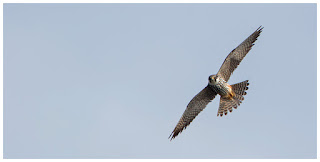Summer appears to be over, and it's been a while since I saw a swallow darting across the skies in search of insects. They along with the subject of this post should be making their way across Europe and down to warmer climates, probably South Africa. Thankfully, before they left, they provided me with hours of entertainment and hundreds of fantastic images.
I am referring to the hobby. This migrant bird of prey spends its summer here in the UK where it breeds, before departing south again, usually in October. The adults tend to leave first, whilst their offspring hang around a little longer, perhaps to build up stamina for the long flight, and also to hone their hunting skills, necessary for life in general.
Back in May I marvelled at the returning adults as they hunted in numbers over the marshes in Oxfordshire. They soon dispersed to set up territories, and I was distracted by other subjects over the summer months. However, I always keep an eye on a few local reserves where I have seen them before, just in case, and as it happened, a hobby started to favour one such reserve early in September. It didn't take me long to go for a look and after a bit of a wait, the hobby suddenly appeared, whizzing overhead at speed to grab a dragonfly.
The reserve is called Marsh Lane and is a private location sited not far from Birmingham Airport. It's a good spot for dragonflies, so I am not surprised the hobby frequented it so often. On my first visits, the hobby would appear for a short period, generally hunting anywhere on the reserve. This made it tricky to predict where was best to stand, and invariably wherever I chose, the hobby would go to the other side.
I say "the" hobby, which is incorrect. At the start of September there were definitely two hobbies around. One adult and the other a juvenile. The adults have a brick red area on their underside (called red trousers sometimes) and their beaks are yellow with a dark tip.
Juveniles lack the coloured underside and their beaks are a blue/grey colour. There are other differences of course, but these are most apparent when looking at the subject through your bins or at the image on the reverse of your camera.
Towards the middle of September, the adult disappeared and only the juvenile remained. It would hunt initially for short bursts, of maybe 15 to 20 minutes at a time, before resting in one of the many trees around the reserve.
When it had filled its crop (the muscular pouch near its throat) it would go to the far side of the reserve and sit in a tree, from which it'd drop down to grab any dragonflies perched up on the reeds below. Unfortunately this perch was impossible to view from anywhere on the reserve without venturing off paths, so when the hobby headed over there, I knew it was time to leave.
As the days went by though, the time spent hunting increased, as the bird became stronger and more experienced at it. While there were still swallows around, I never saw the hobby make any attempt to catch one, staying focused on the insects instead.
By late September the hobby had started to favour one part of the reserve, which wasn't surprising as there always seemed to be dragonflies around. Probably because the stream ran in parallel, meaning the tiny insects the dragonflies were preying upon were in abundance in that area.
I had also ditched the idea of trying to photograph the hobby using the camera on the tripod. As smooth as the UniqBall head is, it limits how high the lens can point, and I just felt I had more chance if I held the lens instead. I'm not built like Arnold Schwarzenegger so can't wield the 500mm for hours at a time, but I found I could hold it up in bursts long enough to get sequences as the hobby hurtled by.
Though my back did ache after a couple of sessions when the hobby hunted continuously for over 2 hours! It was a good work-out for it and me!
I was amused at one point when my quiet afternoon enjoying the antics of the hobby was interrupted by the reserve land management team who were cutting and baling the hay from the meadows. Initially I thought that the session would be ended; the hobby scared away, but if anything the hobby hunted for longer. I think perhaps the disturbance from the grass being cut threw more insects into the air, and gave the hobby more targets. I found myself trying to follow the bird as it darted between the tractors!
According to the reserve's records, the hobby was last seen on the 8th October when it headed south mid-morning. By then though, I had amassed more photographs of it to know what to do with! A wonderful, exciting bird to watch, and I hope it succeeds with its migration. Maybe I'll photograph it in years to come, if it returns to the same area to start its own family.
Now I need to find something else to point the camera at for the winter...













No comments:
Post a Comment